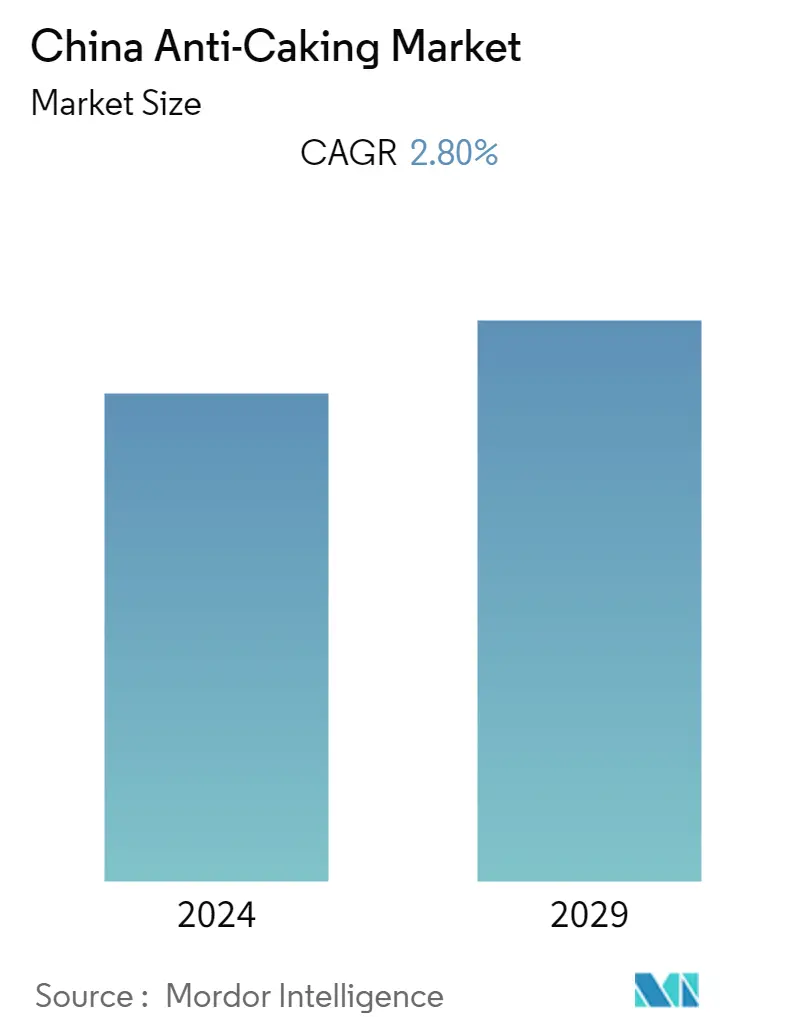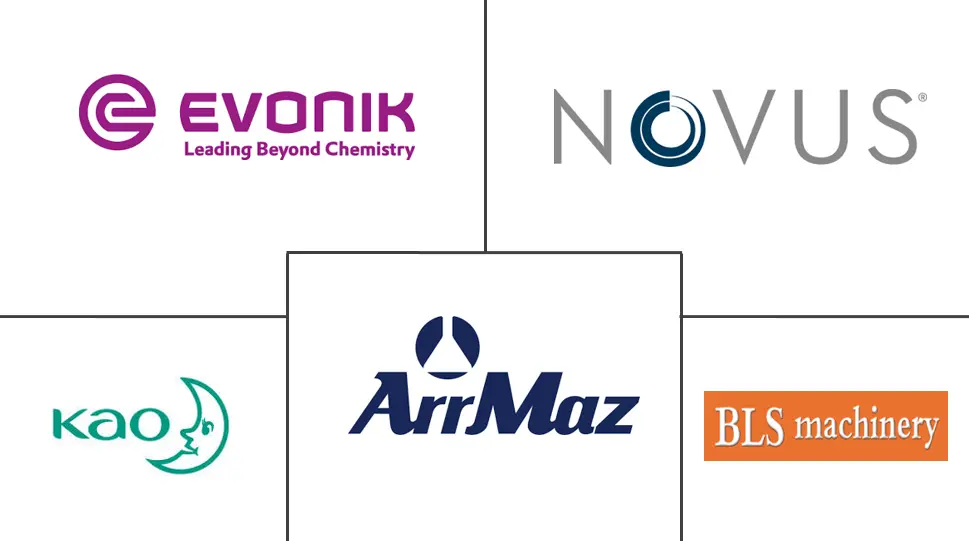Market Size of China Anti-Caking Industry

| Study Period | 2019 - 2029 |
| Base Year For Estimation | 2023 |
| Forecast Data Period | 2024 - 2029 |
| Historical Data Period | 2019 - 2022 |
| CAGR | 2.80 % |
| Market Concentration | Low |
Major Players
*Disclaimer: Major Players sorted in no particular order |
China Anti-Caking Market Analysis
The Chinese anti-caking market is projected to grow at a CAGR of 2.8% during the forecast period 2020 - 2025.
- The market is majorly driven by its increasing demand in all food industries, including bakery, dairy products, soups and sauces, and seasoning and condiments, owing to its functional properties, such as moisture absorption functionality. It also maintains the free-flow, texture, and organoleptic properties of the product, along with enhancing the shelf-life of the product. Thus, the high versatility of anti-caking agents is anticipated to further strengthen its demand during the forecast period. Furthermore, the availability of raw materials and the new technology developments are resulting in the growth of the anti-caking agents in the Chinese market.
- However, only specific amounts of anti-caking agents, which are classification as 'Generally Recognized as Safe' (GRAS), designated by the US Food and Drug Administration, are permitted in food and beverage applications, further limiting its consumption in the application. Also, several health hazards and side-effects associated with anti-caking agents are anticipated to impact the growth of the market negatively.
China Anti-Caking Industry Segmentation
The Chinese anti-caking market is segmented by type into calcium compounds, sodium compounds, magnesium compounds, and other product types. It is also segmented by application into food and beverages, cosmetics and personal care products, animal feed, and other applications (fertilizers, synthetic detergents, and road salts). The food and beverages segment is further divided into dairy, bakery, soup and sauces, and beverages.
| By Type | |
| Calcium Compounds | |
| Sodium Compounds | |
| Magnesium Compounds | |
| Other Types |
| By Application | |||||||
| |||||||
| Cosmetics and Personal Care | |||||||
| Feed | |||||||
| Other Applications |
China Anti-Caking Market Size Summary
The Chinese anti-caking market is experiencing growth driven by its increasing application across various food industries, such as bakery, dairy, soups, sauces, and seasonings. The demand is primarily fueled by the functional benefits of anti-caking agents, which include moisture absorption, maintaining free-flow and texture, and extending product shelf-life. The versatility of these agents is expected to further bolster their market demand. Additionally, advancements in technology and the availability of raw materials are contributing to market expansion. However, the market faces challenges due to regulatory limitations on the use of anti-caking agents in food and beverages, as only those classified as 'Generally Recognized as Safe' by the US FDA are permitted, and concerns over potential health hazards may negatively impact market growth.
In the bakery sector, anti-caking agents play a crucial role in preventing the clumping of powdered ingredients affected by moisture and temperature, ensuring smooth mixing and flow during production. Commonly used agents include bentonite, calcium silicate, silicon dioxide, talc, and sodium aluminosilicate, with regulatory guidelines dictating their usage levels. Calcium compounds, recognized as GRAS, are frequently employed in products like table salt and powdered soft drinks, as well as in tablet and capsule lubrication due to their anti-adherent properties. The Chinese anti-caking market is characterized by intense competition and fragmentation, with numerous regional and domestic players. Companies are focusing on mergers, expansions, acquisitions, partnerships, and new product developments to enhance their market presence, with key players such as Evonik Industries AG, Kao Corporation, and Novus International leading the market.
China Anti-Caking Market Size - Table of Contents
-
1. MARKET DYNAMICS
-
1.1 Market Drivers
-
1.2 Market Restraints
-
1.3 Porter's Five Forces Analysis
-
1.3.1 Threat of New Entrants
-
1.3.2 Bargaining Power of Buyers/Consumers
-
1.3.3 Bargaining Power of Suppliers
-
1.3.4 Threat of Substitute Products
-
1.3.5 Intensity of Competitive Rivalry
-
-
-
2. MARKET SEGMENTATION
-
2.1 By Type
-
2.1.1 Calcium Compounds
-
2.1.2 Sodium Compounds
-
2.1.3 Magnesium Compounds
-
2.1.4 Other Types
-
-
2.2 By Application
-
2.2.1 Food and Beverage
-
2.2.1.1 Bakery Products
-
2.2.1.2 Dairy Products
-
2.2.1.3 Soups and Sauces
-
2.2.1.4 Beverages Mixes
-
2.2.1.5 Other Applications
-
-
2.2.2 Cosmetics and Personal Care
-
2.2.3 Feed
-
2.2.4 Other Applications
-
-
China Anti-Caking Market Size FAQs
What is the current China Anti-Caking Market size?
The China Anti-Caking Market is projected to register a CAGR of 2.80% during the forecast period (2024-2029)
Who are the key players in China Anti-Caking Market?
Evonik Industries AG, Kao Corporation, Qingdao BLS Engineering & Machinery Co. Ltd., Novus International and ArrMaz Products, L.P. are the major companies operating in the China Anti-Caking Market.

